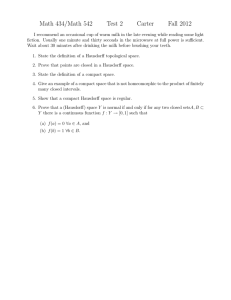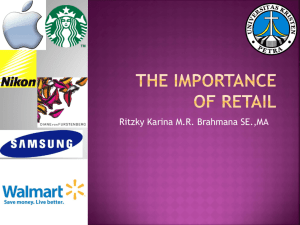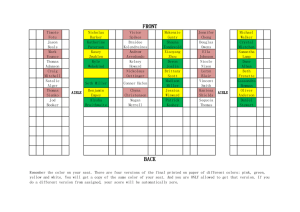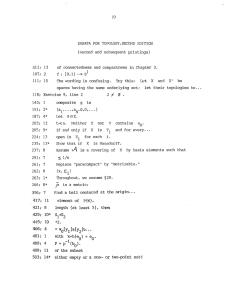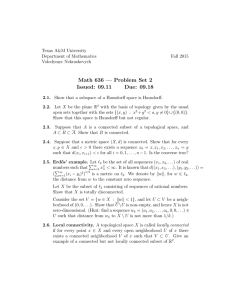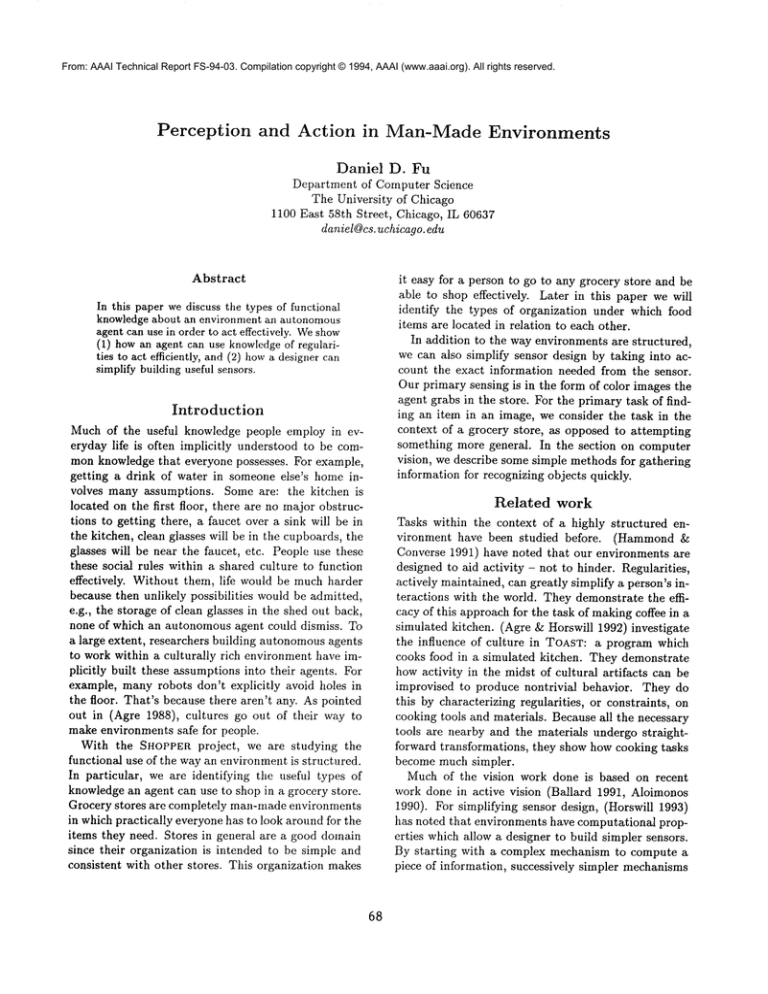
From: AAAI Technical Report FS-94-03. Compilation copyright © 1994, AAAI (www.aaai.org). All rights reserved.
Perception
and Action
in Man-Made Environments
Daniel
D. Fu
Department of Computer Science
The University of Chicago
1100 East 58th Street, Chicago, IL 60637
dauiel©es, uehicago, edu
Abstract
In this paper we discuss the types of functional
knowledgeabout an environment an autonomous
agent can use in order to act effectively. Weshow
(1) howan agent can use knowledgeof regularities to act efficiently, and (2) howa designer can
simplify building useful sensors.
Introduction
Much of the useful knowledge people employ in everyday life is often implicitly understood to be commonknowledge that everyone possesses. For example,
getting a drink of water in someone else’s home involves many assumptions. Some are: the kitchen is
located on the first floor, there are no major obstructions to getting there, a faucet over a sink will be in
the kitchen, clean glasses will be in the cupboards, the
glasses will be near the faucet, etc. People use these
these social rules within a shared culture to function
effectively. Without them, life would be much harder
because then unlikely possibilities would be admitted,
e.g., the storage of clean glasses in the shed out back,
none of which an autonomous agent could dismiss. To
a large extent, researchers building autonomousagents
to work within a culturally rich environment have implicitly built these assumptions into their agents. For
example, many robots don’t explicitly avoid holes in
the floor. That’s because there aren’t any. As pointed
out in (Agre 1988), cultures go out of their way
make environments safe for people.
With the SHOPPER project, we are studying the
functional use of the way an environment is structured.
In particular, we are identifying the useful types of
knowledgean agent can use to shop in a grocery store.
Grocery stores are completely man-madeenvironments
in which practically everyone has to look around for the
items they need. Stores in general are a good domain
since their organization is intended to be simple and
consistent with other stores. This organization makes
68
it easy for a person to go to any grocery store and be
able to shop effectively. Later in this paper we will
identify the types of organization under which food
items are located in relation to each other.
In addition to the way environments are structured,
we can also simplify sensor design by taking into account the exact information needed from the sensor.
Our primary sensing is in the form of color images the
agent grabs in the store. For the primary task of finding an item in an image, we consider the task in the
context of a grocery store, as opposed to attempting
something more general. In the section on computer
vision, we describe some simple methods for gathering
information for recognizing objects quickly.
Related
work
Tasks within the context of a highly structured environment have been studied before. (Hammond
Converse 1991) have noted that our environments are
designed to aid activity - not to hinder. Regularities,
actively maintained, can greatly simplify a person’s interactions with the world. They demonstrate the efficacy of this approach for the task of makingcoffee in a
simulated kitchen. (Agre &: Horswill 1992) investigate
the influence of culture in TOAST:a program which
cooks food in a simulated kitchen. They demonstrate
how activity in the midst of cultural artifacts can be
improvised to produce nontrivial behavior. They do
this by characterizing regularities, or constraints, on
cooking tools and materials. Because all the necessary
tools are nearby and the materials undergo straightforward transformations, they show how cooking tasks
become much simpler.
Much of the vision work done is based on recent
work done in active vision (Ballard 1991, Aloimonos
1990). For simplifying sensor design, (Horswill 1993)
has noted that environments have computational properties which allow a designer to build simpler sensors.
By starting with a complex mechanism to compute a
piece of information, successively simpler mechanisms
Regularities
can be derived by noting regularities an environment
supports. These regularities can be used for analyzing
under what conditions sensors will and won’t work.
Horswill describes POLLY- a robot designed to give
guided tours. Polly’s visual mechanismsare very sireple (optimized) since they’re tailored to a specific environment.
Any adult shopping for groceries in a store can find
the necessary items in reasonable time whether or not
they’ve been to the store before or not. Yet the average
store stocks around 10,000 items. Without knowing
something about a sought item beyond a photograph,
people would have a very difficult time finding a few
items among thousands. Because people can describe
the physical characteristics of their food as well as how
they use it, stores are able organize their food items in
consistent ways so customers can use their knowledge
of food to find items. Belowwe illustrate the different
types of knowledgethat can be used for finding goods.
(Rimey 1993) has studied the influence of a visual
scene’s structure to the performance of a system. Since
an environment is structured, scenes taken of that environment will exhibit that structure also. Rimeyuses
knowledgeof the structure so as to locate and recognize
objects and object groupings.
Shopping
in
in a grocery store
¯ Type
Typically, items that either serve nearly the same
function, or are very similar are nearby each other.
This is a most basic organization principle under
which many items fall under; e.g. McIntosh apples
are near Romeapples; a jar of Gerber baby food will
be found with other baby foods; a tomato clustered
with other vegetables; an apple placed with other
fruits; coffee is near tea.
GroceryWorld
While we would like SHOPPER
to eventually function in
a real store, we have opted to first test it in a simulator
first. There are two reasons for this: (1) A real grocery store is unavailable for frequent testing, and (2)
For now we want to avoid problems with real robots,
like fixing broken hardware, writing motor driver code,
having to transport the robot, etc. Weare also able
to ignore problems such as noise in sonar readings and
wheel slippage; however, we intend to incorporate similar problems in the simulator.
The simulator we have built is called GROCERYWORLD.
This "world" is a novel simulator in that
it integrates some real visual data along with simulated sonar information. While being a simulation,
we still wanted to address some real sensing problems:
GROCERYWORLD
is a videodisc-based reproduction of
a local grocery store. The store has nine aisles of food
items. For each aisle, four film clips were taken of views
of each side as well as up and downthe aisle. In total,
the simulator provides access to over 75,000 images by
merely moving around the store.
GROCERYWORLD
also
provides simulated range information on the relative proximity of objects to the
agent. Sign information is also given. Whenan agent
is at the end of an aisle and looking downthat aisle,
he automatically receives the symbolic text of those
signs. The signs in GROCERYWORLD
are a faithful
reproduction of the signs of the specific grocery store
filmed.
¯ Brand
Within a section of a specific type, the maker of the
food will also be clustered together. For example,
in a typical grocery store aisle, soups of the same
brand (e.g. Campbell’s, Progresso) will be clustered
with each other no matter how similar they. So,
Campbell’s vegetable soup is not placed adjacent to
Progresso vegetable soup.
¯ Counterparts
Items that complement each other. For example,
salad and salad dressing, pancakes and maple syrup,
pasta and tomato sauce, etc.
¯ Physical Constraints
Perishable or bulky items that require special storage considerations like orange juice, eggs, frozen entrees, etc.
¯ Specialty foods
For items commonlyassociated with other countries
or cultures: e.g. soy sauce, curry, matzah, water
cress. These foods tend to be placed nearby each
other in a separate section.
¯ Packaging
Bulk items such as bags of oranges, apples, and potatoes will be placed separate from their individual
versions.
In the next few sections we will illustrate the types
of regularities SItOPPER can use in a grocery store.
Next we discuss the control and visual routines which
make use of these regularities.
Then we step through
an example of SHOPPER finding an item. In the last
section we end with a discussion.
For example, if we wanted to find a box of Frootloops
cereal, a sign above an aisle that says "cereal" serves
69
as a pointer to the location of the cereal using the
regularity of "type."
Action
and
Perception
In this section we discuss the control and visual routines which makeuse of the regularities described earlier.
Control of action and perception
The action mechanismis a version of that used in RUNNER (Hammond, Converse, & Martin 1990). SHOPPER’s control structures are composed of plans. Figure 1 shows the basic algorithm. Initially, a plan is
given a permission to activate. An active plan first
checks to see if its objectives (a success clause) are met.
If so, it finishes. If not, it selects a methodbased on
current context (sensor and state) information. Each
method will have a sequence of plans or actions. These
plans and actions will then be permitted (activated)
sequence, as successive plans succeed.
procedure permit (plan)
if succeeded(plan) then
return true;
else
pick applicable method m;
for i in m’s plan sequence
do if i is an action then
execute action i;
else
permit(i);
(defplan (move-down-aisle-looking-for ?item)
(success (or (see verified ?item)
(not (clear-space forward))))
(method (context (and (see sign ?type)
(isa ?item ?type)))
(serial (align-body-to-head)
(move-out-of-intersection)
(look-for ?item)))
(method (context (and (isa ?item ?type)
(counterpart ?type ?other-type)
(see sign ?other-type)))
(serial (align-body-to-head)
(move-out-of-intersection)
(disable all) ;; deactivate all histograms
;; activate histograms related to signs
(sign-enable)
(look-for-type ?type ?other-type ?item)
(search-vicinity ?item))))
Figure 2: A plan to determine the method of finding
an item in an aisle after a relevant sign is encountered.
¯ The lighting comes from the ceiling.
¯ Items usually sit directly on shelves.
¯ Food items are displayed on shelves in a consistent
manner, e.g. cereal boxes are upright with the front
of the box facing outward.
Basing vision routines on these assumptions allows us
to build a very effective ensemble which, while being
very simple and easy to understand, combine to execute nontrivial visual tasks.
SHOPPERuses three basic vision routines for obtaining information from the images. The routines (in order of increasing complexity) are: shelf detection, histogram intersection,
and comparison of edge images
using Hausdorff distance.
The first routine is a shelf detector. This helps to
constrain the "interesting" regions in an image. Given
that the agent is looking at a side of an aisle, we locate the shelves by assuming that (1) light comes from
above, and (2) the shelves are light in color. From
these assumptions, we build a simple filter sensitive to
changes from light to dark since shadows are cast beneath shelves. The detector histograms the responses
and then finds maxima by partitioning
the 1D histogram. The maximacorrespond to shelf locations in
the image.
The second routine is a histogram intersection routine (Swain 1991). Histogram intersection involves diseretizing the pixels of a food item image into a color
space histogram. Intersection matches are determined
Figure 1: A simplified control mechanism.
Execution of this control mechanism behaves in a
very "depth-first
search" manner by permitting abstract plans which become more and more concrete
depending on sensor/state conditions. The resulting
"leaves" are either physical, visual, or mental actions.
For example "(align-body-to-head)" is a physical action which orients the direction of travel to the direction the head is facing.
In Figure 2, the plan is satisfied if either the item
sought has been spotted, or the end of the aisle has
been reached. If not, a method is chosen. The two
methodslisted in Figure reffig:aplan represent two different search strategies: looking for a specific item, or
looking for an item’s related types and then searching
a local vicinity.
Vision
in GroceryWorld
The vision operations rely on the regularities discussed
in the previous section as well as somesimple assumptions we make about the domain:
7O
by intersecting
two color spaces. Thus any two images
which have the same color pixels content-wise will intersect fully.
The third routine we use is a comparison function
using Hausdorff distance (Huttenlocher
&: Rucklidge
1992) to compare two edge images. Hausdorff distance
is a measure of how close a set of item edge points are
to a set of image edge points, and vice versa.
Because each routine’s speed is related to the size
of the image, we sought to successively limit the size
of regions of interest. So, we first constrain search to
be on shelves. Then, on each shelf we further bound
the region. Finally, we compute the Hausdorff distance
over the smallest region possible. By far, computing
the Hausdorff distance is the most expensive operation.
By taking into account the safe assumptions available
to us, we are able to constrain areas in the image for
processing. Figure 3 shows the three routines in intermediate states.
From these basic routines,
we create more sophisticated
routines for processing
images in GROCERYWORLD.Rather than presenting
them now, we will
describe them later in the context of an example in
the next section.
Example
In this section we illustrate
an example of finding
Mrs. Butterworth’s
pancake mix. According to the
"type" regularity discussed earlier,
we should expect
that Mrs. Butterworth’s
pancake mix be placed near
other pancake mixes. However, there’s no sign saying
"pancake mix". In that c~e, we know if other regularities will (or won’t) apply:
¯ counterparts
cakes.
- Maple syrup is often used with pan-
¯ physical constraints
- Not applicable
not need to be refrigerated.
near each
Because of these regularities
a good place to look is
nearby the maple syrups. As we will demonstrate, this
belief is correct for this particular
example in GROCERYWORLD.
The following is an edited trace of SHOPPERfinding
a box of pancake mix. Of the 159 primitive
actions
done, only illustrative
ones are reported here.
Permitting (find-item mrsbutterworths)
Permitting (find-sign)
[Action: (turning body left)]
At this point, SHOPPER
is looking down an aisle.
information is passed from the simulator:
sign
sign
sign
sign
aisle-l) (see sign bread)
cracker) (see sign cookie)
meat) (see sign frozen-entree)
baked-good)
From here, SHOPPERneeds to turn his body toward an
open area so he can move across the aisles. He’ll then
turn back toward the aisle in order to see signs.
[Action: (turning body left)]
[Action: (turning head to look right)]
Permitting (move-across-aisles-looking-for
mrsbutterworths)
[Action: (moving forward)]
[Action: (moving forward)]
At this point, SHOPPERkeeps moving forward until
relevant sign is seen: syrup.
(see
(see
(see
(see
(see
sign
sign
sign
sign
sign
Sign
71
a
aisle-5) (see sign syrup)
oil) (see sign shortening)
bakery-need) (see sign tea)
coffee) (see sign sugar)
flour)
SHOPPERwill now use a visual routine
we term a
type recognizer=, a routine which indicates the type of
items in an image without recognizing any single item.
Because of the regularity
that items of the same type
are grouped together, we sample color histograms from
the regions above shelves and compare them across the
color histogram database of items. Active items in the
database keep track of their best match value and then
vote for their associated type. If enough responses are
registered for a particular type, we consider the type to
be recognized. Because of the sign information, SHOPPER only considers those histograms directly
related
to the signs by type. This constraint
improves type
recognition by reducing the number of false positives.
Permitting (move-down-aisle-looking-for
mrsbutterworths)
[Action: (aligning body to head)]
[Action: (disabling items of type all)]
[Action: (enabling items of type syrup
oil shortening bakery-need
coffee sugar flour tea)]
Permitting (look-for-type pancake-mix
syrup mrsbutterworths)
[Action: (turning head to look left)]
[Action: (checking for shelves)]
[Action: (checking for type at shelf
position 175)]
[Action: (checking for type at shelf
position 305)]
[Action: (moving forward)]
[Action: (moving forward)]
[Action: (turning head to look right)]
since both do
¯ packaging - Both are small and can reside
other.
(see
(see
(see
(see
Figure 3: From top left: (a) Image of cereal boxes with shelf positions drawn as solid lines. The jagged lines are
made of match values of histograms taken above a shelf against "Frootloops," a cereal. The higher the point, the
better the match. Regions of interest are bounded as seen by the bigger dots on the jagged line. (b) Showsan edge
image taken around "Smacks" for subsequent comparison with Frootloops using Hausdorff distance. (c) Same
in b, but with Frootloops. (d) Frootloops’ edge image is superimposed; it’s found.
sponse and use Hausdorff distance comparison by first
using a precomputed edge image of Mrs. Butterworth’s
and computing an edge image of the region of high response. If the edge images match well, we have verified
the location of the item. If not, we consider the item
to be absent from the image and continue on.
Next, SHOPPER processes images on the left and right
as it moves down the aisle. Eventually, shopper will
reach the syrup section and then begin a local search
routine within the: local region o1’ the aisle.
Permitting
[Action:
[Action:
[Action:
[Action:
(search-vicinity
mrsbutterworths)
(turning body full around)]
(moving forward)]
(moving forward)]
(checking for shelves)]
Now, SHOPPER is looking for Mrs. Butterworth’s.
[Action:
[Action:
It
[Action:
does so using an item recognizer.
By taking
color
histograms
across
and above a shelf
location,
it can
quickly tell if the box is not present if all resulting
in-
(checking
at height
(checking
at height
(verifying
for mrsbutterworths
93)]
for mrsbut~erworths
239)]
if mrsbutterworths
in boundaries 72 to 113 at height 168)]
[Action: (verifying if mrsbutterworths
in boundaries 236 to 339 at height 168)]
[Action: (found mrsbutterworths item)]
tersections
are low in value. In contrast,
if the intersection values are high, we bom~d the regions of high re-
72
In this example, we used regularities
of type and
counterpart in order to design more complicated routines. This merging of simpler visual routines into
more sophisticated routines results in more robust performance at a smaller cost. The color histogram intersection routine could be scanned across the entire image and produce manypossible locations for an object.
However,by itself, it is not enough to reliably verify
the existence of the object. The Hausdorff distance between a model edge image and an entire image yields
more accurate results, but at a prohibitive time cost.
The combinedroutines of shelf detection, color histogramming, and Hausdorff distance not only lessen
computation time, but they also provide more reliable
performance as a whole. The regularities
of the domain allow these visual routines to be combined into
more complex routines. Thus, an examination of the
task makes SHOPPER not only more reliable, but also
permits us to use simpler machinery.
of any image will be warped. Larger items’ edge models will suffer from this problem. Webelieve we can
alleviate this matching problem by de-warping the image.
Weare also investigating the uses of texture for
noticing cans and bottles. Since cans and bottles can
be rotated and stacked in several ways, comparing edge
images using Hausdorff distance is unreliable for both
detection and verification. Although the use of color
histograms is still robust, we are still missing a good
verifier. By characterizing the textures of items, we
believe we can use texture in another routine together
with the other existing routines to find those kinds of
items.
Currently,
we are working on GROCERYWORLD2:
the same grocery store filmed one year later. Because
we took images right from the original videodisc for
models, it was mucheasier to recognize the item again
since it looks very muchthe samesize across sixty or so
frames. However,we are experiencing severe efficiency
difficulties because the new images have items at varying scale (different lens). Searching for objects using
the Hausdorff distance with scale is time-consuming,
taking upwards of five minutes per 100 × 100 region,
depending on given parameters.
Discussion
Regularities are general rules of thumb - not hard and
fast rules. However, they provide fixed points from
which we can base the search for an item, as opposed to
doing exhaustive search. Of course, regularities can be
wrong in instances. SHOPPER
works within the structure of a store maintained by someone else. This can
lead to mistaken beliefs about the locations of objects.
However,when a failure occurs, the regularities which
pointed to a inistaken location can be identified and
then repaired incrementally. Eventually, SHOPPER
can
learn and optimize plans of action over severM visits.
Whennew grocery stores are encountered, the agent
can be better prepared since its knowledge of particular grocery stores serves as a field from which it can
reap the benefits of past experience.
Conclusion
From the example discussed in this paper, we illustrated visual routines which speeded computation by
restricting regions of interest. These optimized the basic recognition routines we had available to us, without
losing effectiveness. Wehave also demonstrated that
the physical search space can be drastically reduced
using functional knowledge of the domain. Certainly,
this knowledge depends on the environment, but everyday life has the same restraints. Any agent working
in an everyday man-made domain can use its knowledge to help facilitate its ownactivity. In this paper
we have shownthe effectiveness of such knowledge.
Status
SHOPPER currently
uses four out of the six regularities outlined earlier: type, counterpart, physical constraint, and ethnic foods. Of the 825 food items in
the database, we initially tested for thirty items. Out
of the thirty, SIIOPPER correctly found eighteen items
(60 percent found). For all but one of the trials,
wrong item was picked. Since many of these items were
relatively small (about 40x50 pixels), we then tried
twenty-five items of larger sizes (cereals, laundry detergents, etc.). Of the twenty-five items: twenty were
found (80 percent found), one was missed by color histogramming, one wrong item was picked and the other
three didn’t match correctly using our set thresholds
for Hausdorff matching. Since we used a wide-angle
lens for filming, items appearing close to the borders
Acknowledgments
This work was supported in part by AFOSRgrant
number AFOSR-91-0112, DARPAcontract
number
F49620-88-C-0058, and Office of Naval Research grant
number N00014-91-J-1185.
References
Agre, P.E. 1988. The dynamic structure of everyday
life. Ph.D. diss., MITDept. of Electrical Engineering
and Computer Science
Agre, P., and Horswill, I. 1992. Cultural Support for
Improvisation. In Proceedings of the Tenth National
Conferenceon Artificial Intelligence, 363-368.
73
Aloimonos, J. 1990. Purposive and Qualitative Active
Vision. In International Conference on Pattern Recognition, 346-360.
Ballard, D. 1991. Animate Vision. Artificial Intelligence 48:57-86.
Horswill, I. 1993. Specialization of Perceptual Processes. Ph.D. diss., MITDept. of Electrical Engineering and Computer Science.
Hammond,K. and Converse, T. 1991. Stabilizing environments to facilitate planning and activity: An engineering argument. In Proceedings of thc Ninth National Conference on Artificial Intelligence, 787-793.
Hammond,K., Converse, T., and Martin, C. 1990. Integrating planning and acting in a case-b~scd framework. In Proceedings of the Eighth N~tional Conference on Artificial Intelligence, 292-297.
Huttenlocher,
D.P., and Rucklidge, W.J. 1992. A
Multi-Resolution Technique for Comparing Images Using the Hausdorff Distance, Technical Report, TR 921321. Dept. of Computer Science, Cornell Univ.
Rimey, R.D. 1993. Studying Control of Selective Perception Using T-World and TEA. In Proceedings IEEE
Workshopon Qualitative Vision, 51-60.
Swain, M.J., and Ballard, D.H. 1991. Color Indexing.
International .lournal of Computr:rVision 7:11-32.

